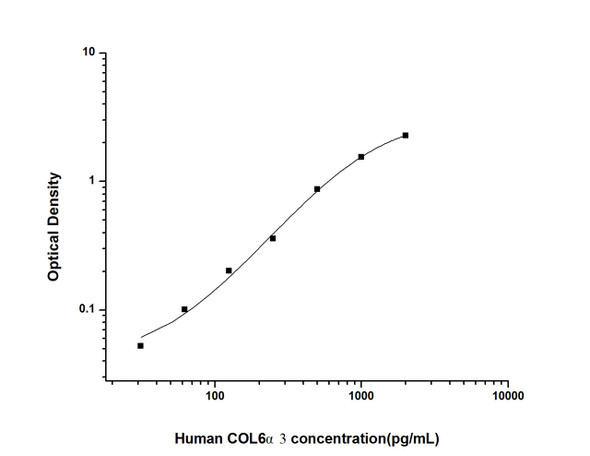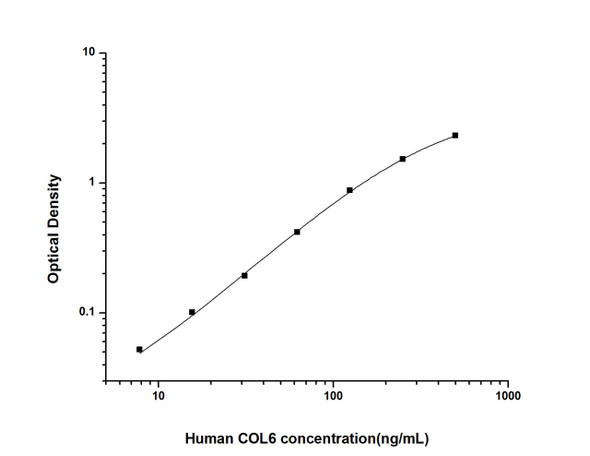Human Cell Biology ELISA Kits 2
Human COL6 alpha1 (Collagen Type VI Alpha 1) ELISA Kit (HUES01918)
- SKU:
- HUES01918
- Product Type:
- ELISA Kit
- Size:
- 96 Assays
- Uniprot:
- P12109
- Sensitivity:
- 0.09ng/mL
- Range:
- 0.16-10ng/mL
- ELISA Type:
- Sandwich
- Reactivity:
- Human
- Sample Type:
- Serum, plasma and other biological fluids
- Research Area:
- Cell Biology
Description
| Assay type: | Sandwich |
| Format: | 96T |
| Assay time: | 4.5h |
| Reactivity: | Human |
| Detection Method: | Colormetric |
| Detection Range: | 0.16-10 ng/mL |
| Sensitivity: | 0.10 ng/mL |
| Sample Volume Required Per Well: | 100µL |
| Sample Type: | Serum, plasma and other biological fluids |
| Specificity: | This kit recognizes Human COL6 alpha1 in samples. No significant cross-reactivity or interference between Human COL6 alpha1 and analogues was observed. |
This ELISA kit uses Sandwich-ELISA as the method. The micro ELISA plate provided in this kit has been pre-coated with an antibody specific to Human COL6 alpha1. Standards or samples are added to the appropriate micro ELISA plate wells and combined with the specific antibody. Then a biotinylated detection antibody specific for Human COL6 alpha1 and Avidin-Horseradish Peroxidase (HRP) conjugate are added to each micro plate well successively and incubated. Free components are washed away. The substrate solution is added to each well. Only those wells that contain Human COL6 alpha1, biotinylated detection antibody and Avidin-HRP conjugate will appear blue in color. The enzyme-substrate reaction is terminated by adding Stop Solution and the color turns yellow. The optical density (OD) is measured spectrophotometrically at a wavelength of 450 nm ± 2 nm. The OD value is proportional to the concentration of Human COL6 alpha1. The concentration of Human COL6 alpha1 in samples can be calculated by comparing the OD of the samples to the standard curve.
| UniProt Protein Function: | COL6A1: Collagen VI acts as a cell-binding protein. Defects in COL6A1 are a cause of Bethlem myopathy (BM). BM is a rare autosomal dominant proximal myopathy characterized by early childhood onset (complete penetrance by the age of 5) and joint contractures most frequently affecting the elbows and ankles. Defects in COL6A1 are a cause of Ullrich congenital muscular dystrophy (UCMD); also known as Ullrich scleroatonic muscular dystrophy. UCMD is an autosomal recessive congenital myopathy characterized by muscle weakness and multiple joint contractures, generally noted at birth or early infancy. The clinical course is more severe than in Bethlem myopathy. Belongs to the type VI collagen family. |
| UniProt Protein Details: | Protein type:Secreted; Secreted, signal peptide; Extracellular matrix Chromosomal Location of Human Ortholog: 21q22. 3 Cellular Component: endoplasmic reticulum lumen; extracellular matrix; extracellular region; lysosomal membrane; membrane; protein complex Molecular Function:platelet-derived growth factor binding Biological Process: collagen catabolic process; extracellular matrix organization and biogenesis; osteoblast differentiation Disease: Bethlem Myopathy; Ullrich Congenital Muscular Dystrophy |
| NCBI Summary: | The collagens are a superfamily of proteins that play a role in maintaining the integrity of various tissues. Collagens are extracellular matrix proteins and have a triple-helical domain as their common structural element. Collagen VI is a major structural component of microfibrils. The basic structural unit of collagen VI is a heterotrimer of the alpha1(VI), alpha2(VI), and alpha3(VI) chains. The alpha2(VI) and alpha3(VI) chains are encoded by the COL6A2 and COL6A3 genes, respectively. The protein encoded by this gene is the alpha 1 subunit of type VI collagen (alpha1(VI) chain). Mutations in the genes that code for the collagen VI subunits result in the autosomal dominant disorder, Bethlem myopathy. [provided by RefSeq, Jul 2008] |
| UniProt Code: | P12109 |
| NCBI GenInfo Identifier: | 125987811 |
| NCBI Gene ID: | 1291 |
| NCBI Accession: | P12109. 3 |
| UniProt Secondary Accession: | P12109,O00117, O00118, Q14040, Q14041, Q16258, Q7Z645 Q9BSA8, |
| UniProt Related Accession: | P12109 |
| Molecular Weight: | 108,529 Da |
| NCBI Full Name: | Collagen alpha-1(VI) chain |
| NCBI Synonym Full Names: | collagen type VI alpha 1 chain |
| NCBI Official Symbol: | COL6A1 |
| NCBI Official Synonym Symbols: | OPLL; BTHLM1; UCHMD1 |
| NCBI Protein Information: | collagen alpha-1(VI) chain |
| UniProt Protein Name: | Collagen alpha-1(VI) chain |
| Protein Family: | Collagen |
| UniProt Gene Name: | COL6A1 |
| UniProt Entry Name: | CO6A1_HUMAN |
As the OD values of the standard curve may vary according to the conditions of the actual assay performance (e. g. operator, pipetting technique, washing technique or temperature effects), the operator should establish a standard curve for each test. Typical standard curve and data is provided below for reference only.
| Concentration (ng/mL) | O.D | Average | Corrected |
| 10 | 2.378 2.414 | 2.396 | 2.323 |
| 5 | 1.689 1.719 | 1.704 | 1.631 |
| 2.5 | 1.005 0.995 | 1 | 0.927 |
| 1.25 | 0.466 0.478 | 0.472 | 0.399 |
| 0.63 | 0.289 0.283 | 0.286 | 0.213 |
| 0.32 | 0.18 0.18 | 0.18 | 0.107 |
| 0.16 | 0.121 0.133 | 0.127 | 0.054 |
| 0 | 0.072 0.074 | 0.073 | -- |
Precision
Intra-assay Precision (Precision within an assay): 3 samples with low, mid range and high level Human COL6 alpha1 were tested 20 times on one plate, respectively.
Inter-assay Precision (Precision between assays): 3 samples with low, mid range and high level Human COL6 alpha1 were tested on 3 different plates, 20 replicates in each plate.
| Intra-assay Precision | Inter-assay Precision | |||||
| Sample | 1 | 2 | 3 | 1 | 2 | 3 |
| n | 20 | 20 | 20 | 20 | 20 | 20 |
| Mean (ng/mL) | 0.53 | 1.07 | 3.54 | 0.56 | 1.11 | 3.74 |
| Standard deviation | 0.03 | 0.06 | 0.16 | 0.03 | 0.05 | 0.16 |
| C V (%) | 5.66 | 5.61 | 4.52 | 5.36 | 4.50 | 4.28 |
Recovery
The recovery of Human COL6 alpha1 spiked at three different levels in samples throughout the range of the assay was evaluated in various matrices.
| Sample Type | Range (%) | Average Recovery (%) |
| Serum (n=5) | 90-107 | 98 |
| EDTA plasma (n=5) | 87-100 | 93 |
| Cell culture media (n=5) | 87-99 | 93 |
Linearity
Samples were spiked with high concentrations of Human COL6 alpha1 and diluted with Reference Standard & Sample Diluent to produce samples with values within the range of the assay.
| Serum (n=5) | EDTA plasma (n=5) | Cell culture media (n=5) | ||
| 1:2 | Range (%) | 98-114 | 90-100 | 98-111 |
| Average (%) | 105 | 95 | 104 | |
| 1:4 | Range (%) | 89-100 | 84-94 | 85-98 |
| Average (%) | 95 | 89 | 92 | |
| 1:8 | Range (%) | 87-101 | 82-95 | 85-98 |
| Average (%) | 93 | 87 | 92 | |
| 1:16 | Range (%) | 90-104 | 84-99 | 88-101 |
| Average (%) | 97 | 91 | 95 |
An unopened kit can be stored at 4°C for 1 month. If the kit is not used within 1 month, store the items separately according to the following conditions once the kit is received.
| Item | Specifications | Storage |
| Micro ELISA Plate(Dismountable) | 8 wells ×12 strips | -20°C, 6 months |
| Reference Standard | 2 vials | |
| Concentrated Biotinylated Detection Ab (100×) | 1 vial, 120 µL | |
| Concentrated HRP Conjugate (100×) | 1 vial, 120 µL | -20°C(shading light), 6 months |
| Reference Standard & Sample Diluent | 1 vial, 20 mL | 4°C, 6 months |
| Biotinylated Detection Ab Diluent | 1 vial, 14 mL | |
| HRP Conjugate Diluent | 1 vial, 14 mL | |
| Concentrated Wash Buffer (25×) | 1 vial, 30 mL | |
| Substrate Reagent | 1 vial, 10 mL | 4°C(shading light) |
| Stop Solution | 1 vial, 10 mL | 4°C |
| Plate Sealer | 5 pieces | |
| Product Description | 1 copy | |
| Certificate of Analysis | 1 copy |
- Set standard, test sample and control (zero) wells on the pre-coated plate and record theirpositions. It is recommended to measure each standard and sample in duplicate. Note: addall solutions to the bottom of the plate wells while avoiding contact with the well walls. Ensuresolutions do not foam when adding to the wells.
- Aliquot 100 µL of standard solutions into the standard wells.
- Add 100 µL of Sample / Standard dilution buffer into the control (zero) well.
- Add 100 µL of properly diluted sample (serum, plasma, tissue homogenates and otherbiological fluids) into test sample wells.
- Cover the plate with the sealer provided in the kit and incubate for 90 min at 37 °C.
- Aspirate the liquid from each well, do not wash. Immediately add 100 µL of BiotinylatedDetection Ab working solution to each well. Cover the plate with a plate seal and gently mix. Incubate for 1 hour at 37 °C.
- Aspirate or decant the solution from the plate and add 350 µL of wash buffer to each welland incubate for 1-2 minutes at room temperature. Aspirate the solution from each well andclap the plate on absorbent filter paper to dry. Repeat this process 3 times. Note: a microplatewasher can be used in this step and other wash steps.
- Add 100 µL of HRP Conjugate working solution to each well. Cover with a plate seal andincubate for 30 min at 37 °C.
- Aspirate or decant the solution from each well. Repeat the wash process for five times asconducted in step 7.
- Add 90 µL of Substrate Reagent to each well. Cover with a new plate seal and incubate forapproximately 15 min at 37 °C. Protect the plate from light. Note: the reaction time can beshortened or extended according to the actual color change, but not by more than 30min.
- Add 50 µL of Stop Solution to each well. Note: Adding the stop solution should be done inthe same order as the substrate solution.
- Determine the optical density (OD value) of each well immediately with a microplate readerset at 450 nm.






